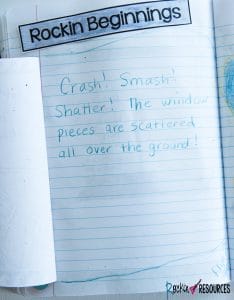Are you looking for ways to help your students write a good lead to their narrative essay? This post will give you ideas to teach what I call ROCKIN’ BEGINNINGS. It is one revision lesson from the series of writing mini lessons for DARE to REVISE. It is part of over 30 lessons for scaffolding in a writer’s workshop curriculum and is the first lesson that focuses on the E for Exchange. Students should exchange their story beginning to grab the reader’s attention!
Get your students excited to write a rockin’ beginning to their story! Follow these steps to help them EXCHANGE their beginnings.
1. TEACH
Explain to the students that E stands for Exchange. Exchange means to trade it. For all of the EXCHANGE mini lessons, they will be exchanging their writing for a better, more exciting version. Tell them that you will be starting with the beginning of the story. There are 10 different ways to make a rockin’ beginning for narrative writing!
1. Onomatopoeia
2. Question
3. Amazing Fact
4. Quote
5. Excitement
6. Opinion
7. Humor
8. Repetition
9. Shocker
10. Curiosity
2. MENTOR TEXT
Start by reading a mentor text. If you have one of our interactive writing notebooks, there is a file for mentor texts in each grade level!
Some good mentor texts are:
The Paper Crane by Molly Bang
The Very Hungry Caterpillar by Eric Carle.
This sample comes from Love, Ruby Lavendar by Deborah Wiles. Read the following. Ask your students: How does it grab your attention? “Murderers! You can’t have them all!” Ruby Lavender leaned out the car window and shook her fist. The car lurched to a halt in the dirt yard of Peterson’s Egg Ranch, and Ruby scrambled out the door. She ran in bare feet as fast as she could into a dusty sea of chickens—a sea of chickens being herded toward their death at the chopping block.
3. MODEL
Modeling is always important. Model the following examples with your students.
Prompt: Write a narrative on taking a time capsule back to the dinosaur era.
1. Onomatopoeia- Stomp, Grumble, Growl
2. Question- What if you came eye to eye with a Tyrannosaurus Rex?
3. Amazing Fact- Did you know the Brachiosaurus was 39 feet tall?
4. Quote- (doesn’t have to be famous) My friend said, “This place is ancient!”
5. Excitement- Oh no! The dinosaur is going to eat me for lunch!
6. Opinion- I think the change in climate killed the dinosaurs.
7. Humor- (simile or hyperbole) The dinosaur is as fast as lightning!
8. Repetition- Help! Help! Help!
9. Shocker- It all started when I was in the mouth of a Brontosaurus!
10. Curiosity- Imagine going back to the time of dinosaurs.
Then model by taking a story your’ve been modeling as a class story and revise the beginning!
4. TAKE NOTES
Whether using interactive writing notebooks, taking notes, or pasting a mini anchor chart in a notebook, students should keep these ideas in their writer’s notebook. They will be able to use it as a reference in future writing!
5. PRACTICE
Ask students: Which do you prefer?
1. Hi My name is Pam. Or Crash, Boom, Bam!
2. I have a favorite teacher. Or Have you ever had a teacher you will never forget? 3. Benjamin Franklin was famous in history. Or “If everyone thinks alike, then no one is thinking.” Benjamin Franklin once said.
Then give students a narrative prompt and ask them to create a rockin beginning using the 10 ideas.
6. APPLY
Students should now go to the rough draft of their story and revise the beginning by exchanging it for a rockin’ one!
7. SHARE
Share, share, share! Students will love to hear each other’s rockin’ beginnings! I hope this post provided you with ideas for teaching students how to be more creative in their narrative writing!
Check out my FREE writing masterclass! CLICK HERE
LAST LESSON: WRITING MINI LESSON #26- DARE TO REVISE- R FOR REARRANGE
NEXT LESSON: WRITING MINI LESSON #28- MILLION DOLLAR WORDS- WORD CHOICE!
CLICK HERE FOR THE FULL LIST OF WRITING MINI LESSONS
This lesson is also included in the STEP-BY-STEP WRITING® Program with mini-lessons designed to scaffold through the writing process. Writing units included are sentence structure, paragraph writing, narrative writing, opinion writing, and informative writing. See what is included in the image below and click on it to learn more about them! You will turn your reluctant writers into ROCKSTAR WRITERS™!
“I love this as it really walks you through the writing process for you AND the students. It has given me confidence to really enjoy writing as well as my students. They love writing time now.” -Melinda R.







